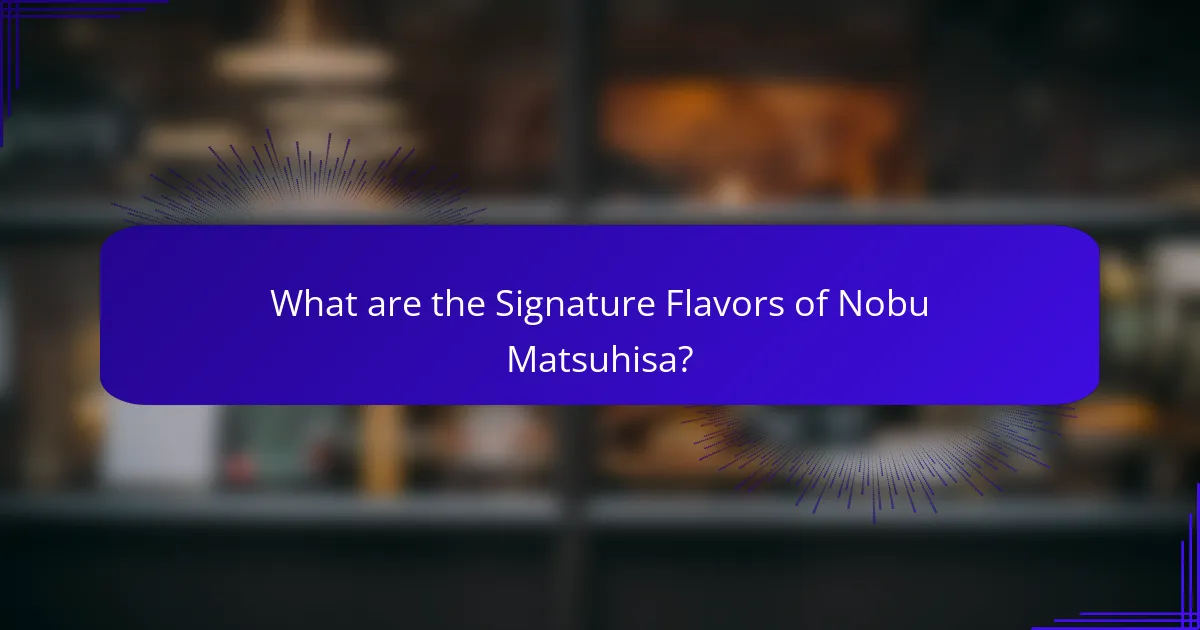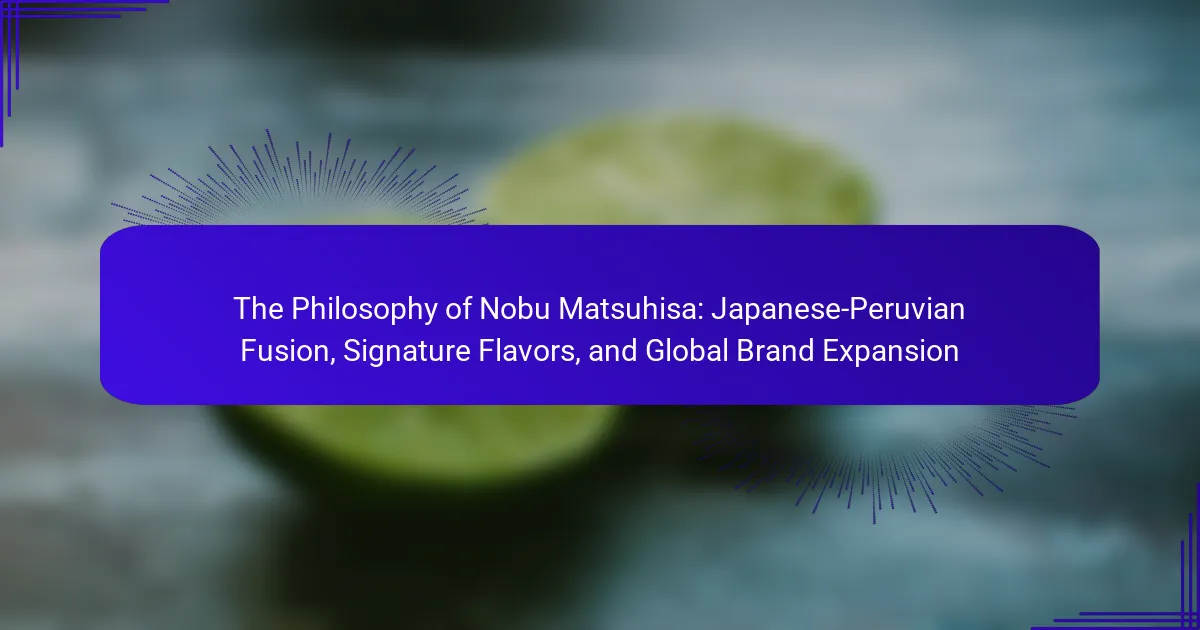
What is the Philosophy of Nobu Matsuhisa?
Nobu Matsuhisa’s philosophy centers on the fusion of Japanese and Peruvian culinary traditions. He emphasizes the importance of fresh, high-quality ingredients. Matsuhisa believes in creating harmony between flavors and textures. His approach highlights simplicity while showcasing the natural essence of each ingredient. This philosophy is evident in signature dishes like Black Cod Miso. He also values innovation and creativity in his culinary techniques. Matsuhisa’s brand expansion reflects his commitment to sharing this philosophy worldwide. His restaurants embody a unique dining experience that merges cultural influences.
How did Nobu Matsuhisa develop his culinary philosophy?
Nobu Matsuhisa developed his culinary philosophy by blending traditional Japanese techniques with Peruvian ingredients. His experience in Japan shaped his understanding of sushi and seafood preparation. After moving to Peru, he was inspired by local flavors and cooking methods. This fusion created unique dishes that reflect both cultures. Matsuhisa emphasizes the importance of fresh, high-quality ingredients in his cooking. He also focuses on simplicity and balance in flavor. His culinary philosophy has been influential in modern global cuisine. Nobu restaurants worldwide showcase this innovative approach.
What influences shaped his approach to Japanese-Peruvian fusion?
Nobu Matsuhisa’s approach to Japanese-Peruvian fusion was shaped by his multicultural background and culinary experiences. Growing up in Japan, he was influenced by traditional Japanese cooking techniques and flavors. His move to Peru introduced him to local ingredients and culinary practices. The blending of these two distinct cuisines inspired his signature dishes. Matsuhisa embraced the use of fresh seafood, a staple in both Japanese and Peruvian cuisine. He incorporated Peruvian spices and herbs to enhance traditional Japanese recipes. This creative fusion led to a unique culinary style that garnered international acclaim. The success of his restaurants is a testament to the harmonious blend of these diverse influences.
How does his background impact his cooking style?
Nobu Matsuhisa’s background significantly impacts his cooking style through the fusion of Japanese and Peruvian cuisines. His Japanese heritage provides a foundation in traditional techniques and flavors. This includes an emphasis on fresh ingredients and precise knife skills. His experience in Peru introduces bold flavors and diverse ingredients. This blend creates unique dishes that reflect both cultures. Nobu’s culinary journey influences his signature dishes, such as Black Cod Miso. His background enables innovative interpretations of classic recipes. Overall, his multicultural experiences shape a distinctive culinary identity.
What are the core principles of Nobu’s culinary philosophy?
Nobu’s culinary philosophy centers on the fusion of traditional Japanese cuisine with Peruvian ingredients. This approach emphasizes fresh, high-quality ingredients sourced sustainably. Nobu Matsuhisa prioritizes simplicity and elegance in presentation. He believes in highlighting natural flavors rather than overwhelming them with heavy sauces. The use of innovative techniques is also a hallmark of his style. Nobu incorporates elements from both cultures, creating unique dishes that appeal to a global palate. His philosophy promotes a harmonious balance between taste and aesthetics. This culinary vision has contributed to the global success of the Nobu brand.
How does Nobu define the concept of fusion in cuisine?
Nobu defines the concept of fusion in cuisine as a harmonious blend of different culinary traditions. This approach emphasizes the use of fresh, high-quality ingredients. Nobu Matsuhisa combines Japanese techniques with Peruvian flavors and ingredients. For example, he incorporates sashimi with Peruvian sauces. This fusion creates unique dishes that maintain the essence of both cuisines. Nobu’s philosophy celebrates innovation while respecting traditional cooking methods. His restaurants exemplify this concept through diverse menus that attract a global audience.
What role do fresh ingredients play in his cooking philosophy?
Fresh ingredients are central to Nobu Matsuhisa’s cooking philosophy. He emphasizes their importance for enhancing flavor and quality. Freshness ensures that each dish retains its natural taste. Matsuhisa believes that high-quality ingredients lead to superior culinary experiences. His approach combines traditional Japanese techniques with Peruvian flavors, showcasing fresh seafood and produce. For example, he often uses locally sourced fish to create authentic dishes. This commitment to freshness is reflected in his signature recipes, such as black cod miso. Overall, fresh ingredients are vital for achieving the distinct flavors that define his cuisine.
How has Nobu Matsuhisa’s philosophy influenced global dining trends?
Nobu Matsuhisa’s philosophy has significantly influenced global dining trends by promoting Japanese-Peruvian fusion cuisine. His approach combines traditional Japanese techniques with Peruvian ingredients, creating unique flavor profiles. This innovative fusion has inspired numerous chefs worldwide to explore cross-cultural culinary practices. Nobu’s emphasis on fresh, high-quality ingredients has also set a standard in fine dining. His restaurants showcase a blend of simplicity and sophistication, appealing to modern diners. The success of Nobu restaurants has led to the proliferation of similar concepts across the globe. This trend reflects a growing consumer interest in diverse culinary experiences. Nobu’s impact is evident in the rise of fusion restaurants that prioritize creativity and cultural integration.
In what ways has his approach changed perceptions of fusion cuisine?
Nobu Matsuhisa’s approach has significantly changed perceptions of fusion cuisine by elevating it to a fine dining experience. He combines traditional Japanese techniques with Peruvian ingredients, creating unique flavor profiles. This innovative blending has introduced new textures and tastes to the culinary world. His signature dishes, like Black Cod Miso, showcase this harmonious integration. By emphasizing quality and presentation, he has set a high standard for fusion cuisine. Nobu’s global restaurant expansion has also popularized these concepts internationally. His influence has shifted fusion cuisine from being seen as a mere trend to a respected culinary art form.
How does Nobu’s philosophy resonate with contemporary dining culture?
Nobu’s philosophy emphasizes a blend of Japanese and Peruvian culinary traditions. This fusion resonates with contemporary dining culture’s focus on global flavors. The emphasis on high-quality ingredients aligns with today’s demand for authenticity. Nobu’s innovative presentation reflects modern aesthetics in dining experiences. The brand’s global expansion showcases the growing trend of culinary exploration. Nobu restaurants often create a communal dining atmosphere, appealing to social dining preferences. Additionally, the commitment to sustainability mirrors contemporary diners’ values. This philosophy not only attracts food enthusiasts but also influences chefs worldwide.

What are the Signature Flavors of Nobu Matsuhisa?
Nobu Matsuhisa’s signature flavors include miso, yuzu, and wasabi. Miso is used in marinades and sauces, enhancing umami. Yuzu adds a citrusy brightness to dishes. Wasabi provides a spicy kick, balancing flavors. Black cod miso is a hallmark dish, showcasing these elements. Nobu’s cuisine blends traditional Japanese techniques with Peruvian ingredients. This fusion creates unique flavor profiles that are globally recognized. Each dish reflects Matsuhisa’s culinary philosophy and cultural influences.
What unique ingredients define Nobu’s signature dishes?
Nobu’s signature dishes are defined by unique ingredients such as miso, yuzu, and black garlic. Miso is used in various marinades and sauces, enhancing umami flavors. Yuzu, a citrus fruit, adds a distinct tartness to dishes. Black garlic contributes sweetness and depth, often featured in sauces. Other notable ingredients include wasabi, truffle oil, and Peruvian chili peppers. These elements reflect Nobu’s Japanese-Peruvian fusion philosophy. They create a harmonious blend of flavors that are both innovative and authentic. Nobu’s commitment to high-quality ingredients ensures the distinctiveness of his culinary creations.
How does Nobu incorporate Peruvian ingredients into Japanese recipes?
Nobu incorporates Peruvian ingredients into Japanese recipes by blending traditional Japanese techniques with Peruvian flavors. For example, Nobu uses ingredients like aji amarillo, a Peruvian chili pepper, to enhance dishes such as sashimi. He also integrates Peruvian corn and potatoes into sushi and ceviche. This fusion creates unique flavor profiles that appeal to diverse palates. Nobu’s approach highlights the versatility of both cuisines. His signature dishes often feature a combination of fresh seafood with zesty Peruvian sauces. The culinary innovation reflects Nobu’s background and influences. This method has contributed to the global popularity of his restaurants.
What techniques does he use to enhance flavor profiles?
Nobu Matsuhisa uses several techniques to enhance flavor profiles in his dishes. He employs the use of umami-rich ingredients such as miso and soy sauce. These ingredients add depth and complexity to the flavors. Matsuhisa also incorporates fresh herbs and spices to brighten dishes. Techniques like marinating proteins in citrus juices amplify taste and tenderness. He combines traditional Japanese cooking methods with Peruvian ingredients for unique flavor fusion. Additionally, the use of high-quality seafood contributes to the overall flavor experience. His signature dishes often feature bold contrasts, balancing sweet, salty, and acidic elements. This approach creates a multi-layered tasting experience that is distinctive and memorable.
How do Nobu’s signature flavors reflect his culinary philosophy?
Nobu’s signature flavors embody his culinary philosophy of blending Japanese and Peruvian influences. His dishes often feature fresh seafood, highlighting the Japanese emphasis on quality ingredients. Nobu employs traditional Japanese techniques, such as sashimi and grilling, while integrating Peruvian elements like aji and citrus. This fusion creates unique flavor profiles that are both delicate and bold. For instance, his Black Cod Miso showcases a sweet and savory balance, reflecting his commitment to harmony in flavors. Additionally, Nobu’s use of umami is central to his approach, enhancing the overall dining experience. His culinary philosophy prioritizes innovation while respecting traditional roots. This duality is evident in how he crafts each dish, ensuring a memorable experience for diners.
What is the significance of umami in his dishes?
Umami is significant in Nobu Matsuhisa’s dishes as it enhances flavor complexity. This fifth taste balances the savory elements in his Japanese-Peruvian fusion cuisine. Umami is derived from ingredients like miso, soy sauce, and seafood. These ingredients create depth and richness in his signature dishes. Research indicates that umami can increase overall satisfaction in meals. Matsuhisa utilizes umami to elevate simple ingredients into extraordinary flavors. This approach aligns with his philosophy of maximizing taste through quality and technique. Thus, umami plays a crucial role in defining the essence of his culinary creations.
How does he balance traditional and modern flavors?
Nobu Matsuhisa balances traditional and modern flavors by integrating Japanese culinary techniques with Peruvian ingredients. He employs methods like sushi preparation while incorporating local elements such as aji amarillo and miso. This fusion creates unique dishes that respect both culinary heritages. For example, the Black Cod Miso showcases traditional Japanese marination with a modern twist. His approach reflects a commitment to authenticity while embracing innovation. This balance has contributed to his global brand’s success and distinct identity in the culinary world.
What are some of the most popular signature dishes at Nobu restaurants?
Nobu restaurants are renowned for several signature dishes. The Black Cod Miso is a standout, featuring marinated fish that is broiled to perfection. Another popular dish is the Yellowtail Jalapeño, which combines fresh fish with a spicy kick. The Tiradito is a unique fusion of Japanese and Peruvian flavors, showcasing sashimi-style fish with a zesty sauce. Additionally, the Nobu-style sushi offers a creative twist on traditional sushi. These dishes exemplify Nobu Matsuhisa’s philosophy of blending Japanese and Peruvian culinary techniques. The popularity of these dishes has contributed to Nobu’s global acclaim and expansion.
What makes Black Cod Miso a standout dish?
Black Cod Miso is a standout dish due to its unique preparation and flavor profile. The black cod is marinated in a sweet miso glaze, which enhances its natural richness. This marinade typically includes ingredients like sake and mirin, contributing to a deep umami taste. The dish is then broiled, creating a caramelized exterior while maintaining a tender, flaky interior. Its balance of sweet and savory flavors makes it appealing to a wide range of palates. Additionally, the dish reflects Nobu Matsuhisa’s philosophy of blending traditional Japanese techniques with innovative ingredients. This fusion approach has garnered international acclaim, solidifying Black Cod Miso as a signature offering at Nobu restaurants worldwide.
How has the Yellowtail Jalapeño become iconic in Nobu’s menu?
The Yellowtail Jalapeño has become iconic in Nobu’s menu due to its unique flavor combination and presentation. This dish features fresh yellowtail sashimi topped with thinly sliced jalapeños. The fusion of Japanese culinary techniques and Peruvian ingredients exemplifies Nobu Matsuhisa’s signature style. It highlights the balance of heat from the jalapeño and the delicate taste of yellowtail. The dish is often served with a citrus soy sauce, enhancing the overall experience. Its popularity has led to it being a staple in Nobu restaurants worldwide. The Yellowtail Jalapeño is frequently cited as a must-try dish by food critics and patrons alike. This acclaim contributes to its iconic status on the menu.

How has Nobu Matsuhisa expanded his global brand?
Nobu Matsuhisa has expanded his global brand through strategic partnerships and franchise models. He collaborated with major hotel chains like Caesars Palace and the Four Seasons. This approach allowed him to reach diverse markets worldwide. Nobu restaurants now exist in over 40 locations across five continents. The unique fusion of Japanese and Peruvian cuisine attracts a wide clientele. Nobu also leverages celebrity endorsements and high-profile events to enhance brand visibility. His commitment to quality and innovation has solidified his reputation in the culinary world. The brand’s luxury positioning appeals to affluent customers seeking unique dining experiences.
What strategies has Nobu used for brand expansion?
Nobu has employed several strategies for brand expansion. Key strategies include strategic partnerships and collaborations. Nobu has partnered with luxury hotels and resorts worldwide. This approach enhances brand visibility and attracts high-end clientele.
Franchising is another critical strategy Nobu has utilized. The brand has expanded its footprint through franchised locations in major cities. This model allows for rapid growth while maintaining brand standards.
Nobu also focuses on culinary innovation. The introduction of unique dishes combines Japanese and Peruvian flavors. This distinct offering differentiates Nobu from competitors.
Marketing efforts emphasize exclusivity and luxury. Nobu’s branding targets affluent customers seeking unique dining experiences.
Finally, Nobu invests in creating a strong brand identity. The brand’s aesthetic and ambiance are carefully curated to reflect its philosophy. These strategies collectively contribute to Nobu’s successful global expansion.
How does Nobu maintain consistency across international locations?
Nobu maintains consistency across international locations through standardized training and operational procedures. Each location follows a detailed manual that outlines recipes, service protocols, and quality standards. This ensures that the unique flavors and dining experience are replicated globally. Nobu also employs a centralized supply chain for key ingredients, maintaining the quality of dishes. Regular audits and feedback loops are implemented to uphold standards across all restaurants. The brand emphasizes staff training programs that reflect Nobu’s culinary philosophy. This approach allows for local adaptation while preserving the core identity of Nobu.
What partnerships have been pivotal in his brand’s growth?
Nobu Matsuhisa’s brand growth has been significantly influenced by partnerships with high-profile hotels and restaurants. Notably, his collaboration with the Kerzner International led to the launch of Nobu restaurants in luxury resorts. The partnership with MGM Resorts International established Nobu as a staple in Las Vegas. Additionally, collaborations with renowned chefs and culinary experts have enhanced Nobu’s brand prestige. These strategic alliances have expanded Nobu’s global presence and attracted diverse clientele. The partnerships have also facilitated the introduction of unique dining experiences, blending Japanese and Peruvian cuisines.
How has the Nobu brand influenced the restaurant industry?
The Nobu brand has significantly influenced the restaurant industry by popularizing Japanese-Peruvian fusion cuisine. This innovative culinary approach combines traditional Japanese techniques with Peruvian ingredients. Nobu’s signature dishes, like Black Cod Miso, have set new standards for fine dining. The brand’s global expansion has also introduced this unique cuisine to markets worldwide. Nobu restaurants are often located in luxury hotels, blending hospitality with high-end dining experiences. This model has inspired many restaurateurs to adopt similar strategies. The brand’s emphasis on quality and presentation has raised expectations in the culinary landscape. Overall, Nobu has redefined upscale dining by merging diverse culinary traditions.
What impact has Nobu had on the perception of luxury dining?
Nobu has significantly elevated the perception of luxury dining. It introduced a unique blend of Japanese and Peruvian cuisines, creating an innovative dining experience. The restaurant’s high-end ambiance and meticulous presentation of dishes reinforce its luxury status. Nobu’s celebrity clientele, including high-profile figures, enhances its allure and exclusivity. The brand’s global expansion has set new standards for luxury dining worldwide. Nobu’s commitment to quality ingredients and exceptional service has redefined expectations in fine dining. Its signature dishes, like Black Cod Miso, have become iconic, further solidifying its reputation. Overall, Nobu has transformed luxury dining into a fusion of culture, exclusivity, and culinary excellence.
How does Nobu balance exclusivity with accessibility in his brand?
Nobu balances exclusivity with accessibility by creating a unique dining experience while expanding globally. The brand offers high-quality Japanese-Peruvian cuisine in upscale environments. Select locations are positioned in luxury markets, enhancing exclusivity. Simultaneously, Nobu has opened restaurants in various cities, making the brand more accessible. The menu features signature dishes that attract a wide audience. Limited-time offerings and collaborations also help maintain interest and exclusivity. This strategy allows Nobu to cater to both high-end clientele and casual diners. The brand’s reputation for excellence further solidifies its appeal across different demographics.
What lessons can aspiring chefs learn from Nobu Matsuhisa’s journey?
Aspiring chefs can learn the importance of innovation from Nobu Matsuhisa’s journey. He successfully merged Japanese and Peruvian cuisines, creating a unique culinary style. This fusion showcases the value of creativity in cooking. Additionally, Matsuhisa emphasizes the significance of high-quality ingredients. He sources fresh, local products to enhance flavor and presentation. Commitment to excellence is another key lesson. Matsuhisa’s dedication to perfecting his craft has led to global recognition. Lastly, building a strong brand is essential. His restaurant chain reflects a cohesive identity that attracts diverse clientele. These lessons highlight the blend of creativity, quality, dedication, and branding in culinary success.
What best practices can be derived from his approach to fusion cuisine?
Nobu Matsuhisa’s approach to fusion cuisine emphasizes the integration of diverse culinary traditions. He combines Japanese techniques with Peruvian ingredients to create unique dishes. This method showcases the importance of balancing flavors and textures. Utilizing fresh, high-quality ingredients is a key practice in his cooking. He also highlights the significance of presentation in enhancing the dining experience. Experimentation with traditional recipes allows for innovation while respecting cultural origins. Collaborating with local chefs can enrich the fusion process. Lastly, maintaining authenticity in flavors while adapting to different palates is vital for success.
How can chefs effectively build a global brand in the culinary world?
Chefs can effectively build a global brand by creating a unique culinary identity. This involves developing signature dishes that reflect their cultural influences and personal style. Consistency in quality and presentation is crucial for brand recognition. Engaging storytelling about the origin of dishes enhances customer connection. Utilizing social media platforms can amplify visibility and reach a broader audience. Collaborations with other chefs or brands can create exciting cross-promotional opportunities. Participating in international culinary events showcases talent on a global stage. Building a strong online presence through a professional website and engaging content fosters brand loyalty.
The main entity of the article is Nobu Matsuhisa, a renowned chef known for his Japanese-Peruvian fusion cuisine. The article outlines Matsuhisa’s culinary philosophy, emphasizing the importance of fresh, high-quality ingredients and the harmonious blending of flavors and textures. It details how his multicultural background and experiences have shaped his innovative approach, leading to signature dishes like Black Cod Miso and Yellowtail Jalapeño. Additionally, the article discusses Nobu’s global brand expansion strategies, the influence of his cuisine on dining trends, and the lessons aspiring chefs can learn from his journey.
